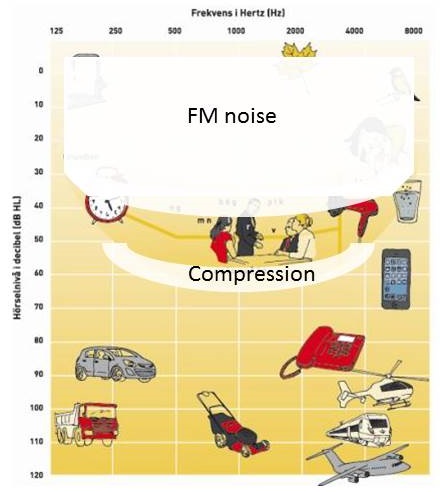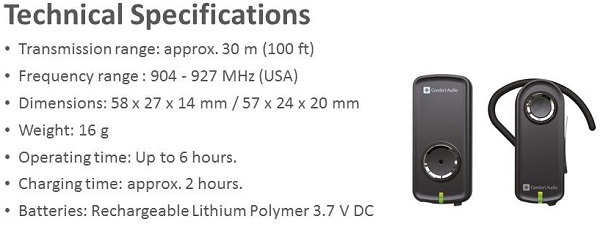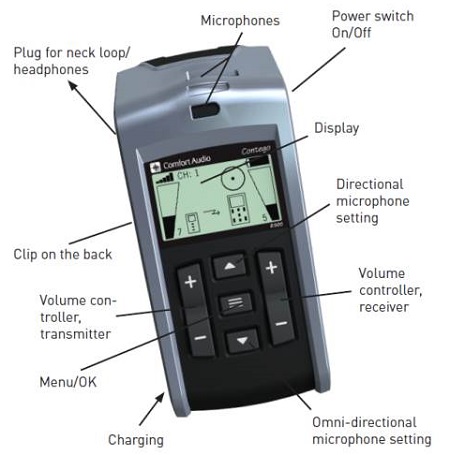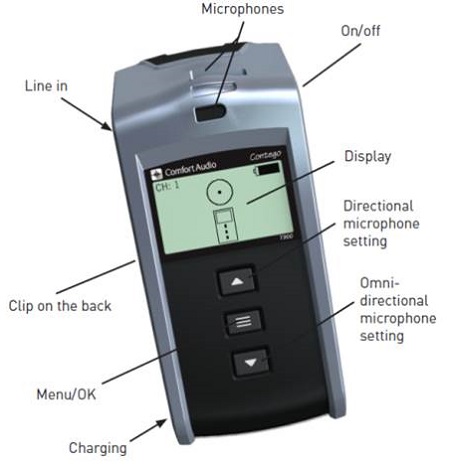Editor’s Note: This text course is an edited transcript of a live webinar. Download supplemental course materials.
Dr. Bill Bielski: Thank you for taking some time to learn about Comfort Audio’s HearYou, which is one of our newer wireless, digitally modulated devices.
Our agenda today will include some history on Comfort Audio and how we got started making these products. We will go through why we offer these products and their various uses. Then I will discuss our proprietary SecureStream Technology. Following that, we will dive into HearYou and what makes it unique. I will present on how we tested the HearYou and then compare it with another assistive listening device that we offer, Contego.
History
Comfort Audio was founded in 1994 by Swedish engineers Carljohan Lagervall and August Pansell. They realized the analog technology that was being used in hearing products at the time was not quite adequate, especially in environments with a lot of background noise. They wanted to take a different route try digital radio transmission instead, which at the time was not thought to be possible. With this in mind, they developed radio technology specifically for assistive listening devices. Today, we serve both children and adults and offer products for use in working life, school, private use at home and in public places as well.
Why Wireless Technology?
Why do we have these products? We know hearing aids have their place as the first line of defense in hearing help in most cases. However, they cannot effectively overcome listening deficits in all complex environments. While they have built-in features for noise reduction, such as directional microphones, for most of us, that is not going to be enough.
There are three things that wireless and frequency-modulated (FM) technologies help to overcome, and those are noise, the effects of distance, and the effects of reverberation. Even though we have this technology and constant innovation to hearing aids, we find that these same issues still come up and that hearing aids cannot address the effects of noise, distance, and reverberation in challenging listening environments. These issues span the entire soundscape. Even individuals with normal hearing have trouble with these particular situations. With this in mind, wireless technology comes into play.
Noise
We know that background noise is one of the main complaints with hearing aids and in general for understanding. Background noise negatively impacts the signal-to-noise ratio (SNR) by masking the speech information and degrading the clarity that is required to understand what is being said. If you couple that with poor word recognition, you then have a very difficult listening situation. Noise can also make it hard to determine where a sound is coming from.
Distance
A hearing aid does not fully address the effect of distance. As we get farther and farther from a sound source, the sound itself degrades in quality. Based on physics, the inverse square law says with each doubling of distance, there is a 6 dB decrease in sound intensity. Essentially, we are saying that as you get farther away, the level of sound reaching your ear is lower.
Reverberation
The third element that a hearing aid struggles to overcome is the effect of reverberation and reflections of sound. This is especially apparent in reverberations from harder surfaces in a room. This increases the background noise and lowers the SNR that we are trying to increase. You see this commonly in rooms with brick walls, high ceilings, tile floors, and when there are chairs with no damping on the bottom. When you put these three elements together, it results in a tough listening environment. Assistive technology can mediate these elements when hearing aids fall short.
Hearing aids do have one proven way to improve SNR, and that is a directional microphone. However, it is not enough. The other options to improve the SNR lie within FM or digitally modulated wireless devices, which will improve the SNR immediately reaching that user’s ear. Hopefully, it will also improve audibility.
Digital Modulation: SecureStream Technology
We provide digital modulation because of the work of our engineers in 1994. Digital modulation is a great improvement over the analog frequency modulation that we had previously. Our digital modulation is called SecureStream Technology, which addresses the deficiencies of FM technology in the early days of the hearing care industry. It cuts down on transmission noise. It limits the effects of dropouts and also addresses the limited dynamic range that analog systems have.
SecureStream Technology is a proprietary digital radio transmission that Comfort Audio created. It is specifically designed to optimize what is important for speech. One of the points that is different and unique in this system is a wide dynamic range. This is over 60 dB, which is a 35 dB improvement in SNR compared to an analog system of the old days. This gives you better access to the speech sounds that you need for audibility.
By having digital sound transmission and digital sound processing, you get a robust and steady signal. This leads to fewer dropouts and security in the transmission itself, since it is an encrypted digital signal. Finally, you do have a much wider system bandwidth at 100 to 7000 HZ, compared to an analog FM.
How is SecureStream Technology Different from FM?
The SecureStream Technology is the heart of all the Comfort Audio Digisystem products, including the HearYou. It serves as the link between the transmitter and the receiver. The digitally modulated signal differs from FM in many ways. Digitally modulated sound utilizes instructions rather than an image of the sound itself, which makes it much more robust and reliable compared to the analog transmissions of the past.
What do I mean by instructions? Let me give you some examples. Figure 1 shows a few paintings of the Mona Lisa. One way to copy the original picture of the Mona Lisa in the middle would be to trust your own talent and draw it freehand. I refer to this as the analog way. The end result is affected by your skill, your patience, your eyesight, and other extraneous factors that determine how well you can replicate the Mona Lisa. If you did it again, it would probably be very different from your first attempt. If you wanted to increase your chances of successfully reproducing that original image, a more effective way would be to give yourself some instructions, as if it was a paint-by-numbers book, which is very specific about what color goes where; this is the comparison to the digital model. The end result would be a much more consistent replication of the original picture, time and time again.

Figure 1. Analogy of analog duplication of a painting, where the center painting of the Mona Lisa is the original signal, and the picture of the left represents free-hand analog replication of the original, and the picture on the right represents a paint-by-number digital replication of the original.
The second example involves cake. If you have a friend in a neighboring country who wants to try a delicious cake you make, how would you get that cake to them? If we were to go the analog way, that would be like making the cake yourself and sending it. What are the chances that the cake makes it there in one piece and is an accurate representation of what you wanted them to have?
If we were to go the digital way, or the instructions route, we would share the instructions with them on how to make the cake, or provide the recipe of the cake. This is a much more effective way of getting the cake to them in a way that is consistent with what you made, but also reproducible. Like digital modulation, it is more repeatable and reliable.
Digital is Better
The way that digital gets that point across is through a very simple system, an all-or-nothing response that we refer to as binary code. Binary code is made up of ones and zeros. It is instructions in its easiest form. It is a yes or no, true or false; nothing is left up to chance. Either the receiver is going to understand the transmission, and it will be great sound quality, or there is going to be no sound at all, which is very different from an analog system where you have distortions and replications that are not good copies of what was produced. Then you take into account that when you get farther and farther away from the transmitter with an analog device, there is more degradation in the sound quality. That is not typically the case with digital modulation.
One other factor that is different with the FM analog transmission of the past and digitally modulated transmission we use today is compression. The older analog system used much more compression for higher inputs and had more inherent noise in the lower frequencies. With the digital modulation philosophy, we limit that compression. You do not have to worry about the low-level noise because it is a digital transmission. If you do need more compression, we let the hearing aid add that on, instead of adding compression on top of compression. This is what allows us to have such a wide, robust dynamic range.
In Figure 2, the blue line on the input/output graph is a representation of a traditional FM system. You have linear input from 55 to 72 dB SPL with automatic gain control that is activated around 72 dB. The red line is a representation of SecureStream Technology. You have that linear input from 30 to 86 dB SPL, with the automatic gain control activating at 86 dB. If more compression is needed, we allow the hearing aid to account for that.

Figure 2. Input-output function of traditional analog system with automatic gain control (blue line) versus SecureStream Technology (red line).
The dynamic range of our devices is shown in Figure 3. This, along with better compression, allows us to deliver very good audibility to the listener.

Figure 3. Dynamic range of Comfort Audio digital modulation.
I want to illustrate this in one other way, and that is to use the speech banana illustration, which shows different speech sounds that are important to understanding a conversational level of speech, around 55 to 65 dB. Figure 4 shows what happens when traditional analog technology is applied.

Figure 4. Effects of low-level analog noise and compression on the speech spectrum.
Inherent low-level noise that is introduced by the analog FM system covers up any softer sounds in the environment. Then you see a good bit compression on the top end of the spectrum (Figure 4). What you have now is a limited transmittable dynamic range.
SecureStream Technology does away with low-level transmission noise that plagues the analog technology, and with a fraction of the compression at the top. Again, if we need more, we allow the hearing aid to apply it, which ultimately provides a wider dynamic range.
Summary of SecureStream Technology
We know that our biggest goal is to improve the SNR. We know that we can do that best by getting the microphone close to the sound source, which can give up to a 25 dB increase in SNR. We know that analog FM introduces of noise and more compression than is needed into the signal, limiting that dynamic range. The best results can be achieved with SecureStream Technology by limiting low-level noise and giving as wide of a dynamic range as possible for audibility. Ultimately, it lets the listener use their hearing instrument to its fullest capabilities.
HearYou Hearing Set
The HearYou (Figure 5) utilizes all the previous technology that I just spoke about. It is an ear-level receiver with a sleek, functional option for individuals, especially in noisy, reverberant situations. We also felt that the HearYou could be used as a first step for those who are not ready to commit to a hearing aid, for those with normal hearing or for individuals who have other difficulties in noise. We do not see it in any way as a means to replace a hearing aid.

Figure 5. HearYou ear-level hearing set and transmitter.
User Situations
Where would you use the HearYou? The hearing aid population might benefit particularly in one-on-one conversations, such as at the dinner table, at the mall, in lectures or driving in the car. We have also found quite a few instances of benefit outside of the adult population. For instance, it has been utilized in one-on-one therapy sessions, in children with auditory processing disorders that do not necessarily have a hearing loss, for children who have attention deficit disorders, and even in individuals with normal hearing that are struggling in background noise.
We all know of patients who are adamant they have a hearing loss because they cannot hear in noise, but they have a normal audiogram and no other contraindications. Rather than ask them to come back and check in another year, the HearYou could be a good solution for them for those particular situations. We see a lot of flexibility in the use of the HearYou. It is not just a niche product.
Features
We designed the HearYou to be a simple and intuitive device. We also wanted it to be discrete and capture individuals that were hesitant to wear a hearing aid because of the stigma associated with it. With that in mind, our engineers designed it to look more like a Bluetooth headset, although it does not have Bluetooth capability. We thought that individuals may be more open to wearing a device to help their hearing and get them on the path of thinking about hearing aids in the future if it looked like a recognizable tech device. This is a bridge to get them used to having something on their ear, as well as getting used to advocating for their own hearing health.
As I stated earlier, HearYou is equipped with the patented SecureStream Technology available in all of our other Digisystem products. It has a dynamic range of up to 60 dB with a bandwidth from 100 to 7000 Hz. Because of the digital transmission, the transmission time is less than 0.3 msec. Because it is digitally encrypted, it is secure against eavesdropping.
The HearYou receiver and transmitter automatically pair when you turn them on. It also has free channel select, which prevents signal transmission on occupied frequencies; you do not have to worry about interference. An additional feature is high immunity against electromagnetic interference. Many newer buildings today are being constructed with steel, and those girders can potentially affect the signal. You do not have to worry about this quite as much because we do have good immunity against electromagnetic interference.
Specifications
I would like to talk about the specifications of the HearYou. The size of the both the receiver and the transmitter are about one inch by two inches. You will get 30 meters, or up to 100 feet, between the receiver and the transmitter. The transmitter is very lightweight at about 16 grams and can operate for up to 6 hours constantly. It takes approximately two hours to fully recharge the lithium polymer batteries.
The device with the hook (Figure 4) is the receiver portion; that ear hook is interchangeable and can be worn on the right or the left ear. The transmitter can be clipped on whoever you want to hear, or it can be placed closest to the sound source that you want to hear. The receiver has a volume control that you can lock if you have an individual, such as a child, who you want to prevent from making inadvertent changes to the volume.
The transmitter has an on/off button on the bottom and an omnidirectional microphone. There is a green LED indicator on both pieces to let you know when the unit is functioning; it will turn orange when the units need to be charged. The transmitter’s omnidirectional microphone has a detection radius of approximately 6 feet. I would suggest that you have it around 12 inches from the sound source. If you are clipping it on a speaker, I recommend that people make the “hang loose” sign and place their thumb close to their lips and the pinkie down on their chest; this distance is about how far away you would want the transmitter from the sound source.
User Testing
We did a bit of testing with the HearYou product before we introduced it to market. Several test individuals had hearing aids and several had undergone hearing testing, but were reluctant to get hearing aids. All of them reported that they were struggling in background noise, whether they had hearing aids or not. There was a wide demographic variety in terms of their hearing history, age, and profession.
We did informal testing, and the evaluation was completed in three parts. There was a basic interview that each person was given. This was done to get a picture of each individual’s daily listening situations and the difficulties that they were having. Each person was given a written questionnaire at the end of 7 to 10 days of testing with the HearYou asking about their experience with the sound quality. It asked about any practical issues that they ran into such as using or charging the device, and any other general concerns or benefits that they noticed while using the device.
We asked everyone how easy it was to find the right volume, keeping in mind that with the initial development of the HearYou, we wanted it to be an easy, intuitive device that did not have a lot of confusing buttons. Seven out of the eight of the individuals that took part said setting the volume control was either easy or very easy. We did have one individual that described it as difficult, and he happened to be the one individual that had severe recruitment. Finding correct volumes at times for him could be challenging.
The second thing we wanted them to judge was the sound quality. All the people that took part rated the sound quality as natural or very close to natural. We questioned them also on how easy it was to use the product. One of the pitfalls of many products is having to put in new batteries. With that in mind, we gave this product a rechargeable battery and made sure that recharging was easy and intuitive. Again, all of the users reported a high level of ease (easy or very easy) in recharging.
We asked in what situations they found the HearYou to be the most helpful. We found that the main benefit was with watching television and also in one-on-one conversations. Additionally, several of the other participants found that it helped in groups and in areas with a lot of background noise. These were all the settings in which we would want to see improvement.
We also had a place on the questionnaire where users could add other open-ended comments. We found a great deal of versatility for the HearYou. People mentioned situations that we had not thought of, and they were getting great benefit. One woman commented, “I used it to sit next to my son while he sleeps.” Using only hearing aids, she did not have the chance to hear him when she left the room. Now she could leave the room and if he woke up, she would be able to hear him through the remote transmitter. Several other individuals also commented on using it as a baby monitor.
Another man commented that he was using it in his shop to hear his customers. In this case, he was not using it so much as a FM device, but more as a personal amplifier. He was wearing the receiver in his ear and the transmitter his shirt to pick up customer’s voices, and his customers simply thought that he was using a Bluetooth device. There is a lot of flexibility in how these individuals chose to use the HearYou.
Which is Best for my Patient: HearYou or Contego?
We have another product called the Contego (Figure 6). It does have some similarities to the HearYou. I would like to go through some situations where the Contego would be right for patients or when the HearYou would be right for patients.

Figure 6. Comfort Audio Contego receiver and transmitter.
The Contego is also a transmitter/receiver digital FM system just like the HearYou, There are many situations that overlap with the HearYou. You can utilize Contego in a lecture or meeting. A big difference is that the Contego can be hardwired to a telephone or a television. The number one difference between the two is that the Contego can connect with hearing aids, while the HearYou does not. Figure 7 is shows the Contego receiver, which does have an environmental microphone built in to it. The HearYou receiver is worn ear-level and does not have an environmental microphone, but receives all its input from the transmitter microphone.

Figure 7. Contego receiver.
The gain you get with the Contego is about 15 dB more than what you would get out of the HearYou. Keep in mind that the HearYou was designed for individuals with normal to mild hearing loss. The Contego can fit a wider variety of hearing losses, and it does have up to 50 dB of gain. It is appropriate for individuals with moderate to some severe hearing losses.
Another difference between the Contego and the HearYou is that you get a directional microphone with the Contego. In terms of size, the Contego is bigger than the HearYou. It is not as sleek, and it is not worn at ear level. You can utilize the Contego with headphones or a neckloop, but again, nothing is going to be worn on the ear like the HearYou.
Figure 8 shows the Contego transmitter; it looks very similar to the receiver. The reason I like to show this is that the transmitter does also have a line-in port. If you are wanting to connect the system to an MP3 player or a computer, the Contego offers those options, whereas the HearYou does not.

Figure 8. Contego transmitter.
Contego Technical Specifications
Many of the Contego specifications are similar to the HearYou because they use the same digital modulation with encryption. The Contego also has a 100-foot range. The weight is a bit more because it is a slightly larger unit, but it still utilizes rechargeable batteries. Battery life is longer because it is a bigger battery. It will last about 20 hours if you run it constantly and takes four hours to fully recharge. Both the HearYou and the Contego will run on the same frequency range of 904 to 926 MHz.
HearYou Specifications
As I said, the HearYou receiver does have an ear hook that can fit on either ear, and the volume control can be locked. HearYou does not have as much gain as the Contego. It will not be recommended for individuals with severe hearing loss. Remember that it is appropriate for users with normal to mild hearing loss.
You can connect more than one HearYou receiver to a transmitter. I would not recommend an entire room full of them, but two or three people would be a feasible situation. This also means that a user can wear a receiver on each on ear and have binaural input.
Case Studies
I would like to go through some case studies and ask you to consider what your product recommendation would be for these individuals.
Case #1
Our first case is "Bill Gates", who is 29 years old. He has a moderate to severe sensorineural hearing loss in both ears. He wears Siemens in-the-ear (ITE) hearing aids equipped with a telecoil. He wants to hear his children in the backseat of his car better. He is working on a limited budget and wants to make sure that he has a secure connection, as well as hear better in church and around work. Between the Contego and the HearYou, what product would work better for Mr. Gates?
This would be the Contego. We know that he wanted something that was easy to use. The Contego is very intuitive and easy to use. The main thing is that he has hearing aids, so he has to have a product that will couple with his hearing aids and provide the gain necessary for his hearing loss. He has hearing aids equipped with a telecoil; a Contego with a neckloop would be a great option. He also is on a limited budget, and the Contego is relatively inexpensive and can fulfill that need. The Contego has great flexibility with both the directional and omnidirectional microphones where he is going to get benefit in a multitude of different environments where he has expressed difficulty.
Case #2
The next case study is for "Warren Buffet", who is also 29 years old. Mr. Buffet has normal to mild high-frequency sensorineural hearing loss in both ears. He is very resistant to hearing aids and refuses to try them. However, Mr. Buffet wants to hear better in noisy restaurants, in his limousine and possibly even in his jet. He is very worried about how it looks, so it has to be cosmetically appealing. He has to hear better at his board meetings. What might be best for Mr. Buffet?
That would be the HearYou. Why would he benefit more from the HearYou? He has a very mild hearing loss, but he refuses to try hearing aids. The HearYou is a good option to provide help in some of his listening environments without committing to hearing aids. Furthermore, in this situation, we do not have to worry about hearing aid connectivity because he is not wearing any. He wants something that is cosmetically appealing, and the Hear You should fulfill that requirement for him. The number one thing is that it will help him hear in noisy environments. He will get a better SNR in noisy restaurants, in the limo, in the jet, and at the board meetings.
Conclusion
I hope you have been able to see how the HearYou and Contego products can be an extension of hearing technology to help you patients hear better in noise and overcome reverberation and distance. Please contact us at Comfort Audio if you have questions about any of our product offerings.
Questions and Answers
How do the units pair with one another?
The units pair with the on/off button on both the mic and the receiver. You will press the power button on the receiver until the LED function light flashes rapidly in green. Then on the microphone, you will press the same on/off button until the LED flashes green rapidly. Then the units will connect with one another. The function indicators will be solid green for about 15 seconds and then they will go back to flashing intermittently. That is how you know that the two units connected.
What frequency signal do the products use?
All the DigiSystem products run on a high-frequency range of 904-927 MHz.
Is there an external microphone that can be plugged into the HearYou transmitter?
There is no external microphone. It is all built into the microphone on the one-piece unit.
Can the HearYou be used to take calls from a phone?
The HearYou itself does not have a phone connection. If you had an individual that had need for a system like this, the Contego would be a better option, because that can come equipped with a phone kit to connect to the phone.
Cite this Content as:
Bielski, B. (2015, January). HearYou with Comfort Audio. AudiologyOnline, Article 13182. Retrieved from https://www.audiologyonline.com.


